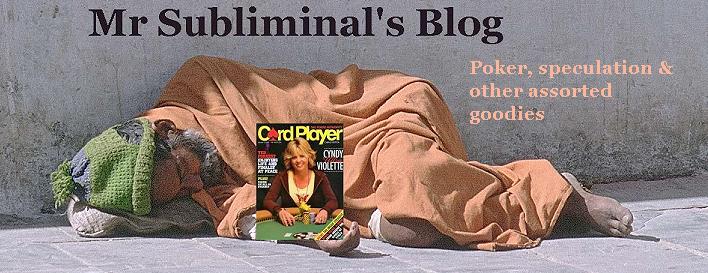I am limited to 30 minutes of internet access per day, and for this I am grateful. As a result, I find it difficult to keep abreast of all the poker blogs I subscribe to in Bloglines. One blog which has recently caught my eye, both for its visual appeal and content, is Steal The Blinds, a joint effort by Jaxia, Beck and Mike. I particularly enjoy Beck's analytical yet colorful descriptions of his adventures at the $1-$2 NL tables, which I vicariously relish most notably when I'm broke and on the rail. His latest post describes a situation which all NL players are familiar with. Please go ahead and read it if you wish to follow the rest of my post, as I have no intention of repeating it here.
I agree with Beck that an all-in reraise was warranted here, and with the gist of his analysis. There are, however, 2 statements which I disagree with. The first is nitpicking on my part, and does not alter the conclusion drawn:
"Unfortunately, the large stack turned over 7s - 8s. He had both a straight draw AND a flush draw, all rolled up in one cute little hand. He had, in other words, 15 outs, not 9. With two cards to come, that made him a favorite in the hand, not a 5-2 dog as I had surmised. His call, astonishingly enough, was perfectly correct here."
The 9s is not an out, so it should be "14 outs, not 8". He is still favorite though.
There is, however, a serious flaw in the following paragraphs:
"If we assume that one person had two pair (probably Ace-Nine, what with how three of the 6s are accounted for by our hand), that one person had an open-ended straight draw, and that another person had a flush draw, there are 18 to 19 outs (depending on whether the person with two pair is holding the 9 of spades) out against you with two cards to come. You are, in other words, a favorite to lose the hand. If someone improves on the turn, the only redraw you will have is one out to quad 6s.
Calling here gives any or all of those outs a chance to catch up. You could end the hand with the third or even fourth best hand despite being in first on the flop. As a consequence, folding here could well be the best EV play, assuming you know that no one is going to fold no matter what you do."
For the scenario outlined above, twodimes gives us the following EV's:
66 (you) 36.5%
OESD 16.1%
Flush draw 29.1%
2 pair 18.3%
Clearly the probability of our winning the hand (36.5%) is less than the probability of losing (63.5%), but we are still the favorite to win the hand (and certainly not a "favorite to lose the hand"). As such, assuming that no one is going to fold, the best EV play is not folding (as suggested by Beck above) but betting as much as we can.
Beck, I really enjoy your well thought out posts. Keep'em coming!




1 comments:
You're absolutely correct about the 14 outs v. 15 outs issue. I realized my mistake just as soon as I got home that day, and I'm glad you reminded me to correct it.
As far as "favorite to lose", you and I are arguing the same point, and the confusion is over semantics. What I meant by "favorite to lose" was simply that there was a greater than 50% chance that I would lose. When discussing pure probability or statistics, my terminology wouldn't have been confusing--when discussing poker, the word "favorite" has a slightly dif. meaning. I am not, as you point out, the most likely of the four to lose--indeed I'm the least likely to lose. But I'm still more likely to lose than win... a point about which you and I are both in perfect agreement.
I'm going to edit my original post to correct the # of outs and reword the section on what I was thinking about the other players hands.
Glad you like reading my posts!
Post a Comment